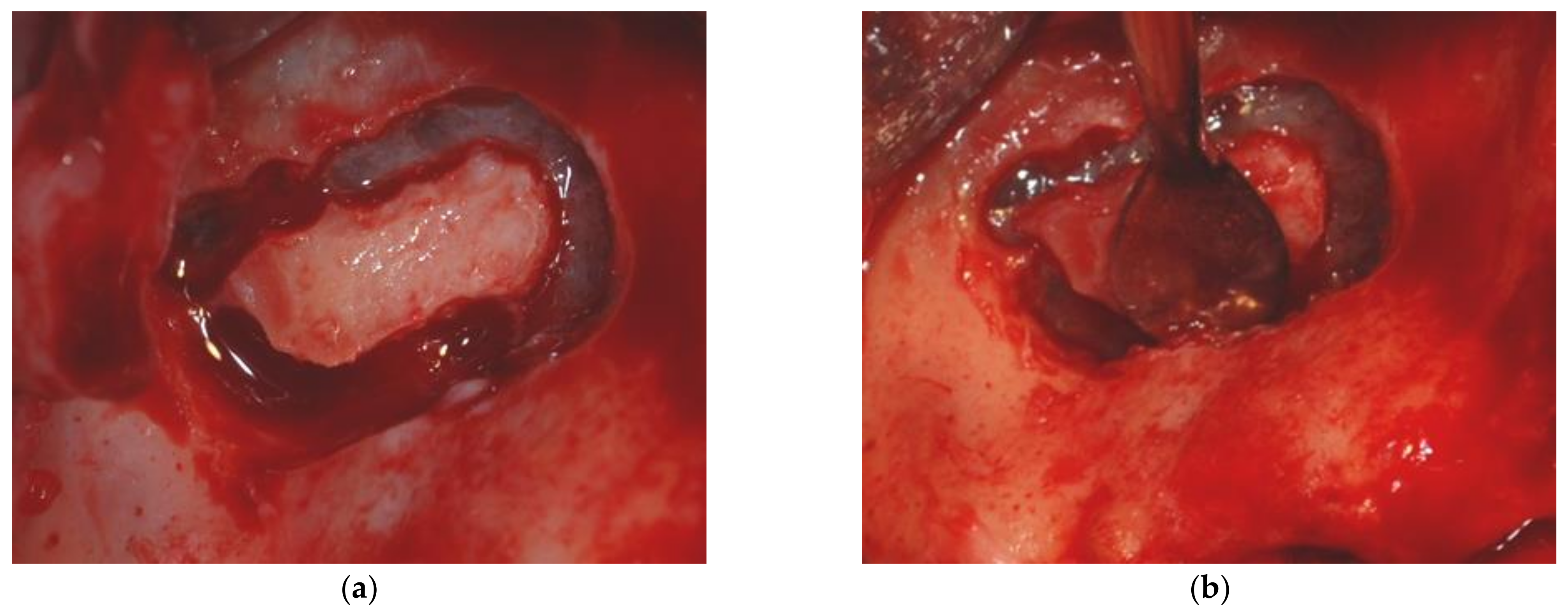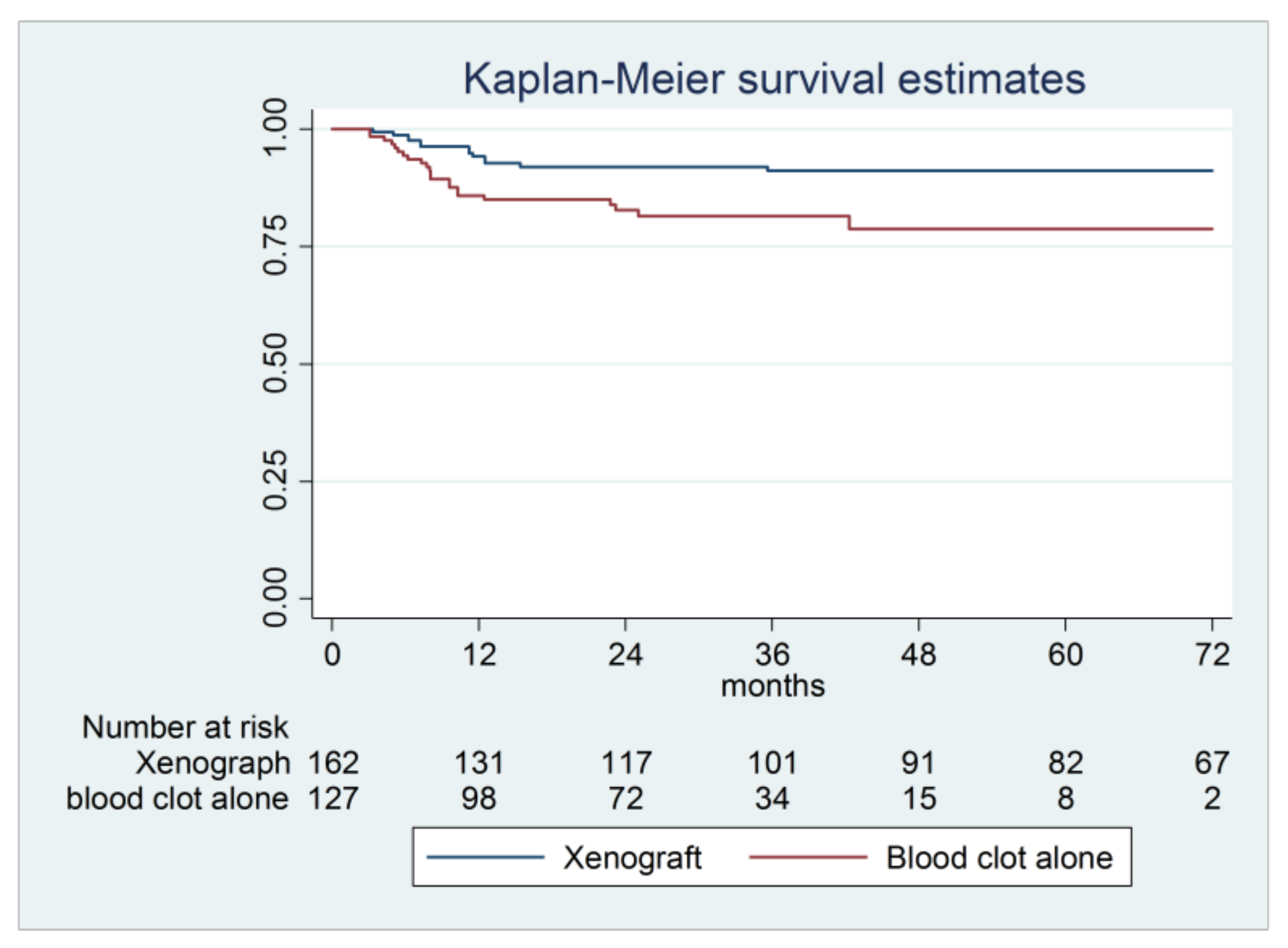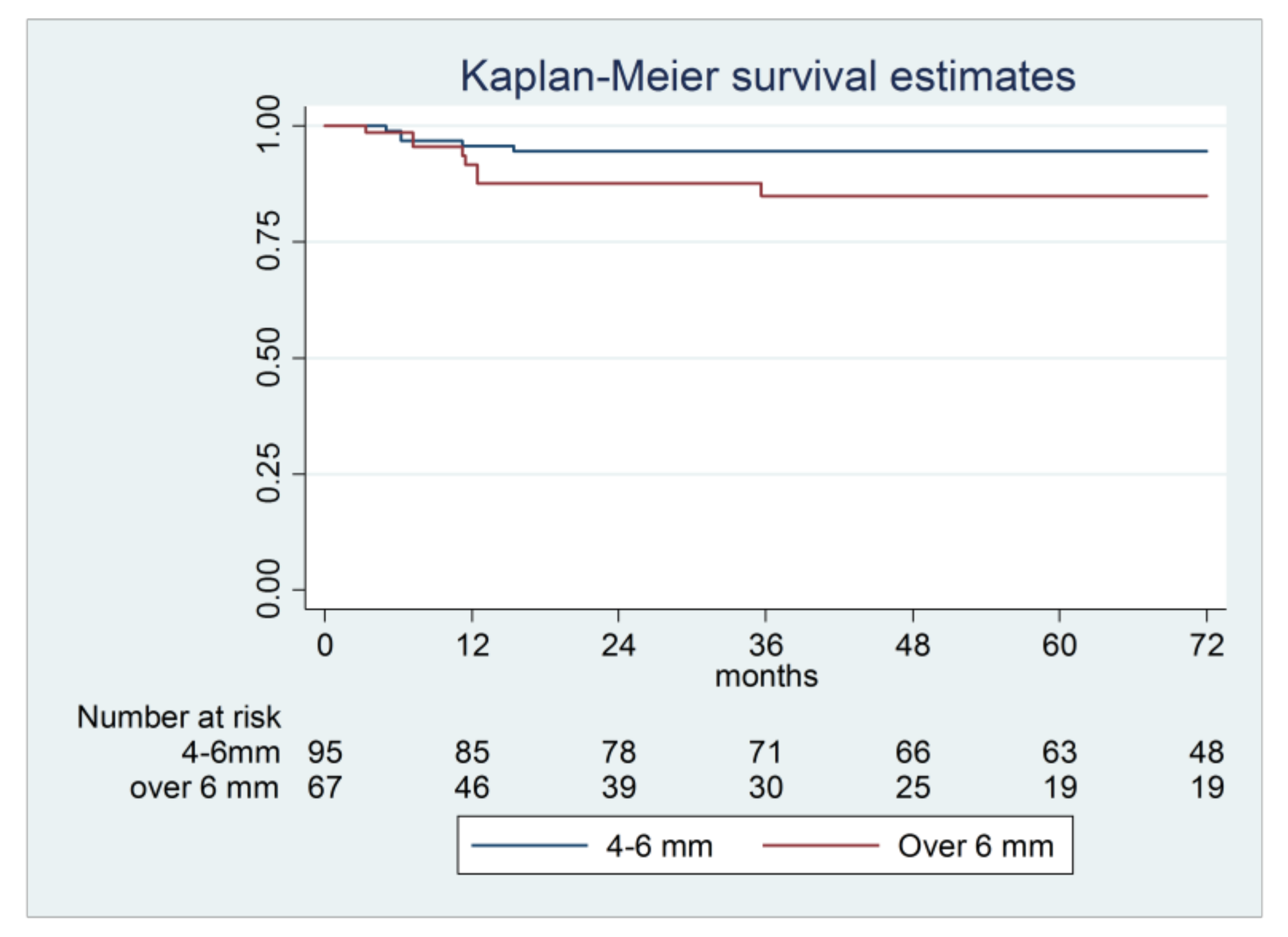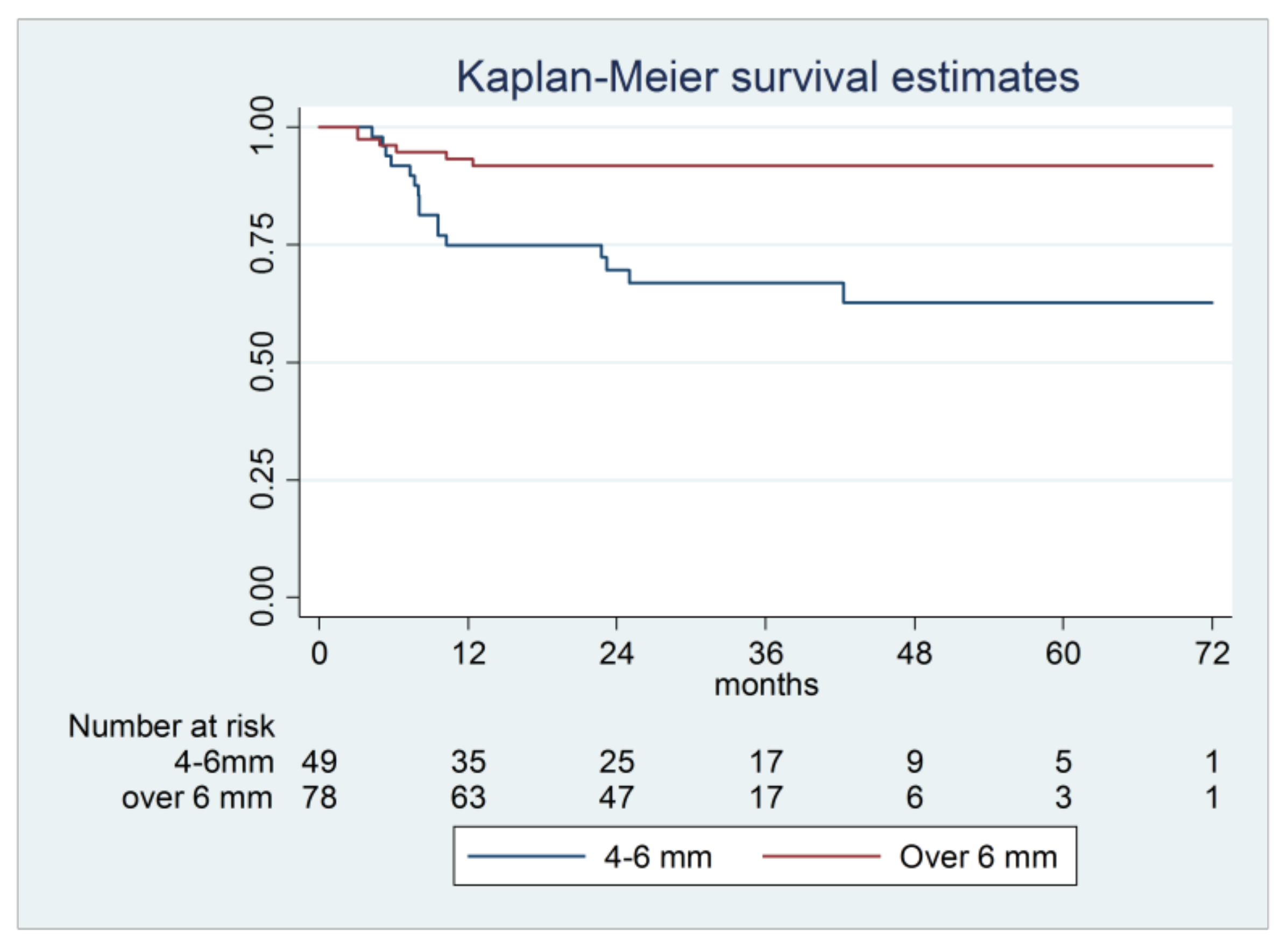Clinical Outcome of Dental Implants after Maxillary Sinus Augmentation with and without Bone Grafting: A Retrospective Evaluation
Abstract
:1. Introduction
2. Materials and Methods
2.1. Patient Selection and Study Design
2.2. Surgical and Prosthetic Procedures
2.3. Patients Follow-Up Assessments
2.4. Statistical Methods
3. Results
4. Discussion
5. Conclusions
Author Contributions
Funding
Institutional Review Board Statement
Informed Consent Statement
Data Availability Statement
Conflicts of Interest
References
- Lamster, I.B. Geriatric periodontology: How the need to care for the aging population can influence the future of the dental profession. Periodontology 2000 2016, 72, 7–12. [Google Scholar] [CrossRef] [PubMed]
- Ohkubo, C.; Morokuma, M.; Yoneyama, Y.; Matsuda, R.; Lee, J.S. Interactions between occlusion and human brain function activities. J. Oral Rehabil. 2012, 40, 119–129. [Google Scholar] [CrossRef] [PubMed]
- Bruschi, G.B.; Crespi, R.; Capparè, P.; Gherlone, E. Transcrestal Sinus Floor Elevation: A Retrospective Study of 46 Patients up to 16 Years. Clin. Implant. Dent. Relat. Res. 2010, 14, 759–767. [Google Scholar] [CrossRef]
- Riben, C.; Thor, A. The Maxillary Sinus Membrane Elevation Procedure: Augmentation of Bone around Dental Implants without Grafts—A Review of a Surgical Technique. Int. J. Dent. 2012, 2012, 1–9. [Google Scholar] [CrossRef] [PubMed]
- A Fugazzotto, P. Sinus floor augmentation at the time of maxillary molar extraction: Technique and report of preliminary results. Int. J. Oral Maxillofac. Implant. 1999, 14, 536–542. [Google Scholar]
- Jensen, T.; Schou, S.; Svendsen, P.A.; Forman, J.L.; Gundersen, H.J.G.; Terheyden, H.; Holmstrup, P. Volumetric changes of the graft after maxillary sinus floor augmentation with Bio-Oss and autogenous bone in different ratios: A radiographic study in minipigs. Clin. Oral Implant. Res. 2011, 23, 902–910. [Google Scholar] [CrossRef]
- Thoma, D.S.; Zeltner, M.; Hüsler, J.; Hämmerle, C.H.F.; Jung, R.E. EAO Supplement Working Group 4-EAO CC 2015 Short implants versus sinus lifting with longer implants to restore the posterior maxilla: A systematic review. Clin. Oral Implant. Res. 2015, 26, 154–169. [Google Scholar] [CrossRef]
- Tuminelli, F.J.; Walter, L.R.; Neugarten, J.; Bedrossian, E. Immediate loading of zygomatic implants: A systematic review of implant survival, prosthesis survival and potential complications. Eur. J. Oral Implant. 2017, 10, 79–87. [Google Scholar]
- Corbella, S.; Taschieri, S.; Weinstein, R.L.; Del Fabbro, M. Histomorphometric outcomes after lateral sinus floor elevation procedure: A systematic review of the literature and meta-analysis. Clin. Oral Implant. Res. 2016, 27, 1106–1122. [Google Scholar] [CrossRef]
- Erdem, N.F.; Çiftçi, A.; Acar, A.H. Three-year clinical and radiographic implant follow-up in sinus-lifted maxilla with lateral window technique. Implant. Dent. 2016, 25, 214–221. [Google Scholar] [CrossRef]
- Beretta, M.; Poli, P.; Grossi, G.; Pieroni, S.; Maiorana, C. Long-term survival rate of implants placed in conjunction with 246 sinus floor elevation procedures: Results of a 15-year retrospective study. J. Dent. 2015, 43, 78–86. [Google Scholar] [CrossRef]
- Marković, A.; Misic, T.; Calvo-Guirado, J.L.; Delgado-Ruíz, R.A.; Janjić, B.; Abboud, M. Two-center prospective, randomized, clinical, and radiographic study comparing osteotome sinus floor elevation with or without bone graft and simultaneous implant placement. Clin. Implant. Dent. Relat. Res. 2015, 18, 873–882. [Google Scholar] [CrossRef]
- De Oliveira, G.R.; Olate, S.; Cavalieri-Pereira, L.; Pozzer, L.; Asprino, L.; De Moraes, M.; De Albergaria-Barbosa, J.R. Maxillary sinus floor augmentation using blood without graft material. Preliminary results in 10 patients. J. Oral Maxillofac. Surg. 2013, 71, 1670–1675. [Google Scholar] [CrossRef]
- Gonzalez, S.; Tuan, M.-C.; Ahn, K.M.; Nowzari, H. Crestal approach for maxillary sinus augmentation in patients with ≤4 mm of residual alveolar bone. Clin. Implant. Dent. Relat. Res. 2013, 16, 827–835. [Google Scholar] [CrossRef]
- Pinchasov, G.; Juodzbalys, G. Graft-free sinus augmentation procedure: A literature review. J. Oral Maxillofac. Res. 2014, 5, e1. [Google Scholar] [CrossRef] [Green Version]
- Bassi, A.; Pioto, R.; Faverani, L.; Canestraro, D.; Fontão, F. Maxillary sinus lift without grafting, and simultaneous implant placement: A prospective clinical study with a 51-month follow-up. Int. J. Oral Maxillofac. Surg. 2015, 44, 902–907. [Google Scholar] [CrossRef] [PubMed]
- Riben, C.; Thor, A. Follow-up of the sinus membrane elevation technique for maxillary sinus implants without the use of graft material. Clin. Implant. Dent. Relat. Res. 2015, 18, 895–905. [Google Scholar] [CrossRef] [PubMed]
- Pozzi, A.; Moy, P.K. Minimally Invasive Transcrestal Guided Sinus Lift (TGSL): A Clinical Prospective Proof-of-Concept Cohort Study up to 52 Months. Clin. Implant. Dent. Relat. Res. 2013, 16, 582–593. [Google Scholar] [CrossRef] [PubMed] [Green Version]
- Thor, A.; Sennerby, L.; Hirsch, J.M.; Rasmusson, L. Bone Formation at the maxillary sinus floor following simultaneous elevation of the mucosal lining and implant installation without graft material: An evaluation of 20 patients treated with 44 astra tech implants. J. Oral Maxillofac. Surg. 2007, 65, 64–72. [Google Scholar] [CrossRef] [PubMed]
- Gu, Y.-X.; Shi, J.-Y.; Zhuang, L.-F.; Qian, S.-J.; Mo, J.-J.; Lai, H.-C. Transalveolar sinus floor elevation using osteotomes without grafting in severely atrophic maxilla: A 5-year prospective study. Clin. Oral Implant. Res. 2014, 27, 120–125. [Google Scholar] [CrossRef]
- Taschieri, S.; Ofer, M.; Corbella, S.; Testori, T.; Dellavia, C.; Nemcovsky, C.; Canciani, E.; Francetti, L.; Del Fabbro, M.; Tartaglia, G. The Influence of Residual Alveolar Bone Height on Graft Composition after Maxillary Sinus Augmentation Using Two Different Xenografts: A Histomorphometric Comparative Study. Materials 2020, 13, 5093. [Google Scholar] [CrossRef] [PubMed]
- Mittal, Y.; Jindal, G.; Garg, S. Bone manipulation procedures in dental implants. Indian J. Dent. 2016, 7, 86–94. [Google Scholar] [CrossRef] [PubMed] [Green Version]
- Falah, M.; Sohn, D.-S.; Srouji, S. Graftless sinus augmentation with simultaneous dental implant placement: Clinical results and biological perspectives. Int. J. Oral Maxillofac. Surg. 2016, 45, 1147–1153. [Google Scholar] [CrossRef] [Green Version]
- Lundgren, S.; Anderson, S.; Gualini, F.; Sennerby, L. Bone reformation with sinus membrane elevation: A new surgical technique for maxillary sinus floor augmentation. Clin. Implant. Dent. Relat. Res. 2004, 6, 165–173. [Google Scholar] [CrossRef] [PubMed]
- Lundgren, S.; Andersson, S.; Sennerby, L. Spontaneous bone formation in the maxillary sinus after removal of a cyst: Coincidence or consequence? Clin. Implant. Dent. Relat. Res. 2003, 5, 78–81. [Google Scholar] [CrossRef] [PubMed]
- Boyne, P.J.; A James, R. Grafting of the maxillary sinus floor with autogenous marrow and bone. J. oral Surg. (American Dent. Assoc. 1965) 1980, 38, 613–616. [Google Scholar]
- Tatum, H., Jr. Maxillary and sinus implant reconstructions. Dent. Clin. North Am. 1986, 30, 207–229. [Google Scholar]
- Boyne, P.J. Analysis of performance of root-form endosseous implants placed in the maxillary sinus. J. Autom. Inf. Sci. 1993, 3, 143–159. [Google Scholar]
- Ellegaard, B.; Kølsen-Petersen, J.; Baelum, V. Implant therapy involving maxillary sinus lift in periodontally compromised patients. Clin. Oral Implant. Res. 1997, 8, 305–315. [Google Scholar] [CrossRef]
- Ellegaard, B.; Baelum, V.; Kolsen-Petersen, J. Non-grafted sinus implants in periodontally compromised patients: A time-to-event analysis. Clin. Oral Implant. Res. 2006, 17, 156–164. [Google Scholar] [CrossRef]
- Chen, T.-W.; Chang, H.-S.; Leung, K.-W.; Lai, Y.-L.; Kao, S.-Y. Implant placement immediately after the lateral approach of the trap door window procedure to create a maxillary sinus lift without bone grafting: A 2-year retrospective evaluation of 47 implants in 33 patients. J. Oral Maxillofac. Surg. 2007, 65, 2324–2328. [Google Scholar] [CrossRef]
- Dellavia, C.; Dds, G.T.; Sforza, C. Histomorphometric analysis of human maxillary sinus lift with a new bone substitute biocomposite: A preliminary report. Clin. Implant. Dent. Relat. Res. 2009, 11, e59–e68. [Google Scholar] [CrossRef] [PubMed]
- Dellavia, C.; Speroni, S.; Pellegrini, G.; Gatto, A.; Maiorana, C. A new method to evaluate volumetric changes in sinus augmentation procedure. Clin. Implant. Dent. Relat. Res. 2013, 16, 684–690. [Google Scholar] [CrossRef] [PubMed]
- Wasserman, B.H.; Geiger, A.M.; Turgeon, L.R. Relationship of occlusion and periodontal disease part VII—Mobility. J. Periodontol. 1973, 44, 572–578. [Google Scholar] [CrossRef] [PubMed]
- Bandlish, R.; McDonald, A.; Setchell, D. Assessment of the amount of remaining coronal dentine in root-treated teeth. J. Dent. 2006, 34, 699–708. [Google Scholar] [CrossRef] [PubMed]
- Chuang, S.; Wei, L.; Douglass, C.; Dodson, T. Risk factors for dental implant failure: A strategy for the analysis of clustered failure-time observations. J. Dent. Res. 2002, 81, 572–577. [Google Scholar] [CrossRef] [PubMed]
- Vlassis, J.M.; Fugazzotto, P.A. A classification system for sinus membrane perforations during augmentation procedures with options for repair. J. Periodontol. 1999, 70, 692–699. [Google Scholar] [CrossRef]
- Tartaglia, G.M.; Sidoti, E.; Sforza, C. Seven-year prospective clinical study on zirconia-based single crowns and fixed dental prostheses. Clin. Oral Investig. 2014, 19, 1137–1145. [Google Scholar] [CrossRef]
- Tartaglia, G.M.; Maiorana, C.; Gallo, M.; Codari, M.; Sforza, C. Implant-supported immediately loaded full-arch rehabilitations. Implant. Dent. 2016, 25, 74–82. [Google Scholar] [CrossRef] [PubMed] [Green Version]
- Van Steenberghe, D. Outcomes and their measurement in clinical trials of endosseous oral implants. Ann. Periodontol. 1997, 2, 291–298. [Google Scholar] [CrossRef]
- Renvert, S.; Persson, G.R.; Pirih, F.Q.; Camargo, P.M. Peri-implant health, peri-implant mucositis, and peri-implantitis: Case definitions and diagnostic considerations. J. Clin. Periodontol. 2018, 45, S278–S285. [Google Scholar] [CrossRef] [Green Version]
- A Fugazzotto, P.; Vlassis, J. Long-term success of sinus augmentation using various surgical approaches and grafting materials. Int. J. Oral Maxillofac. Implant. 1998, 13, 52–58. [Google Scholar]
- Lundgren, S.; Johansson, A.S.; Cricchio, G.; Lundgren, S. Clinical outcome and factors determining new bone formation in lateral sinus membrane elevation with simultaneous implant placement without grafting material: A cross-sectional, 3-17 year follow-up study. Clin. Implant. Dent. Relat. Res. 2019, 21, 827–834. [Google Scholar] [CrossRef]
- Altintas, N.Y.; Senel, F.C.; Kayıpmaz, S.; Taskesen, F.; Pampu, A.A.; Kayipmaz, S. Comparative radiologic analyses of newly formed bone after maxillary sinus augmentation with and without bone grafting. J. Oral Maxillofac. Surg. 2013, 71, 1520–1530. [Google Scholar] [CrossRef]
- Cara-Fuentes, M.; Machuca-Ariza, J.; Ruiz-Martos, A.; Ramos-Robles, M.; Martinez-Lara, I. Long-term outcome of dental implants after maxillary augmentation with and without bone grafting. Med. Oral Patol. Oral y Cir. Bucal 2016, 21, e229–e235. [Google Scholar] [CrossRef]
- Nedir, R.; Nurdin, N.; Khoury, P.; Perneger, T.; El Hage, M.; Bernard, J.-P.; Bischof, M. Osteotome sinus floor elevation with and without grafting material in the severely atrophic maxilla. A 1-year prospective randomized controlled study. Clin. Oral Implant. Res. 2012, 24, 1257–1264. [Google Scholar] [CrossRef] [PubMed]
- Borges, F.L.; Dias, R.O.; Piattelli, A.; Onuma, T.; Cardoso, L.A.G.; Salomão, M.; Scarano, A.; Ayub, E.; Shibli, J.A. Simultaneous sinus membrane elevation and dental implant placement without bone graft: A 6-month follow-up study. J. Periodontol. 2011, 82, 403–412. [Google Scholar] [CrossRef] [PubMed]
- Si, M.-S.; Zhuang, L.-F.; Gu, Y.-X.; Mo, J.-J.; Qiao, S.-C.; Lai, H.-C. Osteotome sinus floor elevation with or without grafting: A 3-year randomized controlled clinical trial. J. Clin. Periodontol. 2013, 40, 396–403. [Google Scholar] [CrossRef] [PubMed]
- Si, M.-S.; Shou, Y.-W.; Shi, Y.-T.; Yang, G.-L.; Wang, H.-M.; He, F.-M. Long-term outcomes of osteotome sinus floor elevation without bone grafts: A clinical retrospective study of 4–9 years. Clin. Oral Implant. Res. 2016, 27, 1392–1400. [Google Scholar] [CrossRef] [PubMed]
- Rosen, P.S.; Summers, R.; Mellado, J.R.; Salkin, L.M.; Shanaman, R.H.; Marks, M.H.; A Fugazzotto, P. The bone-added osteotome sinus floor elevation technique: Multicenter retrospective report of consecutively treated patients. Int. J. Oral Maxillofac. Implant. 1999, 14, 853–858. [Google Scholar]
- Pjetursson, B.E.; Lang, N.P. Sinus floor elevation utilizing the transalveolar approach. Periodontol. 2000 2014, 66, 59–71. [Google Scholar] [CrossRef]
- Călin, C.; Petre, A.; Drafta, S. Osteotome-mediated sinus floor elevation: A systematic review and meta-analysis. Int. J. Oral Maxillofac. Implant. 2014, 29, 558–576. [Google Scholar] [CrossRef] [Green Version]
- Sul, S.-H.; Choi, B.-H.; Li, J.; Jeong, S.-M.; Xuan, F. Effects of sinus membrane elevation on bone formation around implants placed in the maxillary sinus cavity: An experimental study. Oral Surgery, Oral Med. Oral Pathol. Oral Radiol. Endodontology 2008, 105, 684–687. [Google Scholar] [CrossRef]
- Starch-Jensen, T.; Schou, S. Maxillary sinus membrane elevation with simultaneous installation of implants without the use of a graft material. Implant. Dent. 2017, 26, 621–633. [Google Scholar] [CrossRef] [PubMed]
- Testori, T.; Del Fabbro, M.; Bianchi, F.; Francetti, L.; Weinstein, R.L.; Feldman, S.; Vincenzi, G.; Sullivan, D.; Rossi, R.; Anitua, E. A multicenter prospective evaluation of 2-months loaded Osseotite® implants placed in the posterior jaws: 3-year follow-up results. Clin. Oral Implant. Res. 2002, 13, 154–161. [Google Scholar] [CrossRef]
- Chrcanovic, B.R.; Albrektsson, T.; Wennerberg, A. Reasons for failures of oral implants. J. Oral Rehabil. 2014, 41, 443–476. [Google Scholar] [CrossRef] [PubMed]
- Danesh-Sani, S.A.; Movahed, A.; Elchaar, E.S.; Chan, K.C.; Amintavakoli, N. Radiographic evaluation of maxillary sinus lateral wall and posterior superior alveolar artery anatomy: A cone-beam computed tomographic study. Clin. Implant. Dent. Relat. Res. 2016, 19, 151–160. [Google Scholar] [CrossRef]
- Zijderveld, S.A.; Bergh, J.P.V.D.; Schulten, E.A.; Bruggenkate, C.M.T. Anatomical and surgical findings and complications in 100 consecutive maxillary sinus floor elevation procedures. J. Oral Maxillofac. Surg. 2008, 66, 1426–1438. [Google Scholar] [CrossRef]
- Neiva, R.F.; Gapski, R.; Wang, H.-L. Morphometric analysis of implant-related anatomy in caucasian skulls. J. Periodontol. 2004, 75, 1061–1067. [Google Scholar] [CrossRef] [PubMed]
- Cruz, R.S.; Lemos, C.A.A.; Batista, V.E.S.; Oliveira, H.F.F.E.; Gomes, J.M.L.; Pellizzer, E.P.; Verri, F.R. Short implants versus longer implants with maxillary sinus lift. A systematic review and meta-analysis. Braz. Oral Res. 2018, 32, e86. [Google Scholar] [CrossRef] [Green Version]
- Hadzik, J.; Kubasiewicz-Ross, P.; Nawrot-Hadzik, I.; Gedrange, T.; Pitułaj, A.; Dominiak, M. Short (6 mm) and regular dental implants in the posterior maxilla–7-years follow-up study. J. Clin. Med. 2021, 10, 940. [Google Scholar] [CrossRef]
- Thoma, D.S.; Haas, R.; Sporniak-Tutak, K.; Garcia, A.; Taylor, T.D.; Hämmerle, C.H.F. Randomized controlled multicentre study comparing short dental implants (6 mm) versus longer dental implants (11–15 mm) in combination with sinus floor elevation procedures: 5-Year data. J. Clin. Periodontol. 2018, 45, 1465–1474. [Google Scholar] [CrossRef] [PubMed]
- Tan, W.C.; Lang, N.P.; Zwahlen, M.; Pjetursson, B.E. A systematic review of the success of sinus floor elevation and survival of implants inserted in combination with sinus floor elevation Part II: Transalveolar technique. J. Clin. Periodontol. 2008, 35, 241–254. [Google Scholar] [CrossRef] [PubMed]
- Pjetursson, B.E.; Rast, C.; Brägger, U.; Schmidlin, K.; Zwahlen, M.; Lang, N.P. Maxillary sinus floor elevation using the (transalveolar) osteotome technique with or without grafting material. Part I: Implant survival and patients’ perception. Clin. Oral Implant. Res. 2009, 20, 667–676. [Google Scholar] [CrossRef] [PubMed]
- Glantz, P.-O.J.; Nilner, K. Biomechanical aspects of prosthetic implant-borne reconstructions. Periodontol. 2000 1998, 17, 119–124. [Google Scholar] [CrossRef] [PubMed]
- Ravidà, A.; Barootchi, S.; Alkanderi, A.; Tavelli, L.; Del Amo, F.S.-L. The effect of crown-to-implant ratio on the clinical outcomes of dental implants: A systematic review. Int. J. Oral Maxillofac. Implant. 2019, 34, 1121–1131. [Google Scholar] [CrossRef]
- Nedir, R.; Nurdin, N.; Huynh-Ba, G.; Bischof, M. Change in crown-to-implant ratio of implants placed in grafted and nongrafted posterior maxillary sites: A 5-year prospective randomized study. Int. J. Oral Maxillofac. Implant. 2019, 34, 1231–1236. [Google Scholar] [CrossRef] [PubMed]




| Xenograft | Blood Clot | p-Value | |
|---|---|---|---|
| N° of patients | 64 | 72 | |
| Age (mean ± SD) | 61 ± 12.2 | 61 ± 11.8 | 0.344 1 |
| N° of sinuses | 80 | 82 | |
| N° of implants | 162 | 127 | |
| RABH 4–6 mm | 95 | 49 | |
| RABH > 6 mm | 67 | 78 | |
| Sex | |||
| Male N° (%) | 39 (60.94%) | 38 (52.77%) | 0.919 2 |
| Smokers | 11 (17.18%) | 11 (15.28%) | 0.090 2 |
| Alcohol consumers | |||
| N° (%) | 8 (12.5%) | 6 (8.33%) | 0.425 2 |
| Implant Supported Full-Arch Rehabilitation | Extended Gap Rehabilitation | Single Tooth Replacement | |
|---|---|---|---|
| N° of Patients | 21 | 82 | 33 |
| Blood Clot Group | 11 | 44 | 17 |
| Xenograft Group | 10 | 38 | 16 |
| N° of Implants/Failures | |||
| Blood Clot Group | 19-April | 88/14 | 20-April |
| RABH 4–6 mm | 03-June | 30-September | 13-April |
| RABH > 6 mm | 13-January | May-58 | 7/0 |
| Xenograft Group | 29-May | 103/5 | 30-March |
| RABH 4–6 mm | 18-March | January-56 | 21-January |
| RABH > 6 mm | 02-November | April-47 | 02-September |
| 12 Months | 36 Months | 72 Months | ||||||||
|---|---|---|---|---|---|---|---|---|---|---|
| TF 1 | SR 2 (%) | 95% CI | SR (%) | 95% CI | SR (%) | 95% CI | HR 3 | 95% CI | p-Value | |
| Xenograft | 13 | 94.20 | 89.1–96.9 | 91.10 | 85.1–94.8 | 91.10 | 85.1–94.8 | 1 | ||
| Blood Clot | 22 | 85.90 | 78.3–91.0 | 81.60 | 73.0–87.6 | 78.70 | 68.2–86.1 | 3.06 | 1.39–6.77 | 0.006 * |
| Xenograft Group | ||||||||||
| RAB 4–6 mm | 5 | 95.70 | 89.0–98.4 | 94.60 | 87.5–97.7 | 94.60 | 87.5–97.7 | 1 | ||
| RAB over 6 mm | 8 | 91.70 | 81.0–96.5 | 84.90 | 71.6–92.3 | 84.90 | 71.6–92.3 | 2.65 | 0.72–9.79 | 0.143 |
| Blood clot Group | ||||||||||
| RAB 4–6 mm | 16 | 74.90 | 60.0–84.9 | 66.80 | 50.7–78.6 | 62.60 | 45.4–75.7 | 1 | ||
| RAB over 6 mm | 6 | 93.30 | 84.5–97.2 | 91.80 | 82.6–96.2 | 91.80 | 82.6–96.2 | 0.23 | 0.08–0.66 | 0.006 * |
Publisher’s Note: MDPI stays neutral with regard to jurisdictional claims in published maps and institutional affiliations. |
© 2021 by the authors. Licensee MDPI, Basel, Switzerland. This article is an open access article distributed under the terms and conditions of the Creative Commons Attribution (CC BY) license (https://creativecommons.org/licenses/by/4.0/).
Share and Cite
Tartaglia, G.M.; Poli, P.P.; Connelly, S.T.; Maiorana, C.; Farronato, D.; Taschieri, S. Clinical Outcome of Dental Implants after Maxillary Sinus Augmentation with and without Bone Grafting: A Retrospective Evaluation. Materials 2021, 14, 2479. https://doi.org/10.3390/ma14102479
Tartaglia GM, Poli PP, Connelly ST, Maiorana C, Farronato D, Taschieri S. Clinical Outcome of Dental Implants after Maxillary Sinus Augmentation with and without Bone Grafting: A Retrospective Evaluation. Materials. 2021; 14(10):2479. https://doi.org/10.3390/ma14102479
Chicago/Turabian StyleTartaglia, Gianluca Martino, Pier Paolo Poli, Stephen Thaddeus Connelly, Carlo Maiorana, Davide Farronato, and Silvio Taschieri. 2021. "Clinical Outcome of Dental Implants after Maxillary Sinus Augmentation with and without Bone Grafting: A Retrospective Evaluation" Materials 14, no. 10: 2479. https://doi.org/10.3390/ma14102479
APA StyleTartaglia, G. M., Poli, P. P., Connelly, S. T., Maiorana, C., Farronato, D., & Taschieri, S. (2021). Clinical Outcome of Dental Implants after Maxillary Sinus Augmentation with and without Bone Grafting: A Retrospective Evaluation. Materials, 14(10), 2479. https://doi.org/10.3390/ma14102479










